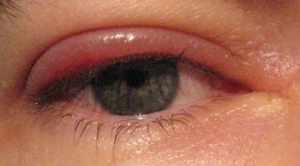

MedFriendly®


Blepharitis
Blepharitis is inflammation of the eyelids, usually where
the hairs of the eyelashes are located. Inflammation of
the margins of the eyelids is known as blepharitis
marginalis. Blepharitis is associated with numerous
(swelling), redness, itching, gritty, and burning
sensations, skin flaking, and the formation of crust, all
in the eyelid area. The crust formation is usually worse
when awakening.
Inflammation of the eyelid.
FEATURED BOOK: The Eye Book: A Complete Guide to Eye Disorders and Health
There are sometimes scales that stick to the bottom of the eyelashes and the eyelashes
can eventually fall out. When blepharitis is charactertized by inflmmation of the eyelid
margins in which the eyelashes are powdered by dry scales, this is known as blepharitis
sicca.
Vision can be reduced and debris may be present in the tear film. Depending on how
severe the condition is, the eyelids can also become scarred.
Blepharitis is caused by too much oil produced by the glands near the eyelids, which in
turn, causes excess bacteria growth.
The condition is known to be associated with rosacea, which is a skin condition that
causes facial redness and can cause swelling and skin sores that look like acne.
"Where Medical Information is Easy to Understand"™
Blepharitis can be seen with seborrhea, which is an inflammatory skin
disorder affecting the scalp, face, and upper body. It can be seen with
repeated bumps on the eyes (known as styes) or a type of cyst on the
eyelid margin. A cyst is an abnormal lump, swelling, or sac that
contains fluid, a part solid material, or a gas, and is covered with a
membrane. Less commonly, blepharitis can be seen with allergies or
lice that affect the eyelids. When the latter occurs, it is known as
blepharitis parasitica, pediculous blepharitis, or blepharitis phthiriatica.
Blepharitis can be diagnosed by an optometrist or ophthalmologist
(types of eye doctors) based on a physical examination of the eyes.
Other doctors can also diagnose the condition such as a
dermatologist (skin doctor) or family medicine doctor.
Blepharitis is treated by carefully cleaning the edges of the eyelids to remove the excess skin oil.
Likewise, blepharitis can be prevented by cleaning the eyelids carefully and treating any skin conditions in
the area. No-tears baby shampoo combined with warm water may be suggested as a cleanser because it
is less irritating. Other special cleansing solutions and/or antibiotic ointments may be suggested. Usually,
this is applied with a cotton swab twice a day (morning and before going to sleep) where the eyelash
meets the eyelid. The prognosis is good with treatment. Without treatment, the condition often resolves in
2 to 4 weeks. However, in some people, it can be a chronic problem. Blepharitis comes from the Greek
word “blepharon” meaning “eyelid” and the Greek word “itis” meaning “inflammation.” Put the words
together and you have “an eyelid inflammation.”















